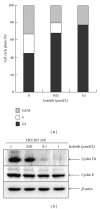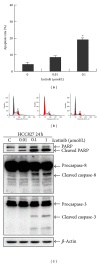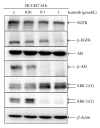Ubiquitin ligase Cbl-b is involved in icotinib (BPI-2009H)-induced apoptosis and G1 phase arrest of EGFR mutation-positive non-small-cell lung cancer
- PMID: 23586056
- PMCID: PMC3615596
- DOI: 10.1155/2013/726375
Ubiquitin ligase Cbl-b is involved in icotinib (BPI-2009H)-induced apoptosis and G1 phase arrest of EGFR mutation-positive non-small-cell lung cancer
Abstract
Epidermal growth factor receptor (EGFR) is one of the most promising targets for non-small-cell lung cancer (NSCLC). Icotinib, a highly selective EGFR tyrosine kinase inhibitor (EGFR-TKI), has shown promising clinical efficacy and safety in patients with NSCLC. The exact molecular mechanism of icotinib remains unclear. In this study, we first investigated the antiproliferative effect of icotinib on NSCLC cells. Icotinib significantly inhibited proliferation of the EGFR-mutated lung cancer HCC827 cells. The IC50 values at 48 and 72 h were 0.67 and 0.07 μ M, respectively. Flow cytometric analysis showed that icotinib caused the G1 phase arrest and increased the rate of apoptosis in HCC827 cells. The levels of cyclin D1 and cyclin A2 were decreased. The apoptotic process was associated with activation of caspase-3, -8, and poly(ADP-ribose) polymerase (PARP). Further study revealed that icotinib inhibited phosphorylation of EGFR, Akt, and extracellular signal-regulated kinase. In addition, icotinib upregulated ubiquitin ligase Cbl-b expression. These observations suggest that icotinib-induced upregulation of Cbl-b is responsible, at least in part, for the antitumor effect of icotinib via the inhibition of phosphoinositide 3-kinase (PI3K)/Akt and mitogen-activated protein kinase pathways in EGFR-mutated NSCLC cells.
Figures






References
-
- Sica GL, Gal AA. Lung cancer staging: pathology issues. Seminars in Diagnostic Pathology. 2012;29(3):116–126. - PubMed
-
- Chen L-K, Liang Y, Yang Q-Y, et al. Triplet platinum-based combination sequential chemotherapy improves survival outcome and quality of life of advanced non-small cell lung cancer patients. Asian Pacific Journal of Cancer Prevention. 2012;13(5):1863–1867. - PubMed
-
- Gan HK, Burgess AW, Clayton AHA, Scott AM. Targeting of a conformationally exposed, tumor-specific epitope of EGFR as a strategy for cancer therapy. Cancer Research. 2012;72(12):2924–2930. - PubMed
-
- Thongprasert S, Duffield E, Saijo N, Wu YL, Yang JC, Chu DT, et al. Health-related quality-of-life in a randomized phase III first-line study of gefitinib versus carboplatin/paclitaxel in clinically selected patients from Asia with advanced NSCLC (IPASS) Journal of Thoracic Oncology. 2011;6:1872–1880. - PubMed
Publication types
MeSH terms
Substances
LinkOut - more resources
Full Text Sources
Other Literature Sources
Medical
Research Materials
Miscellaneous

